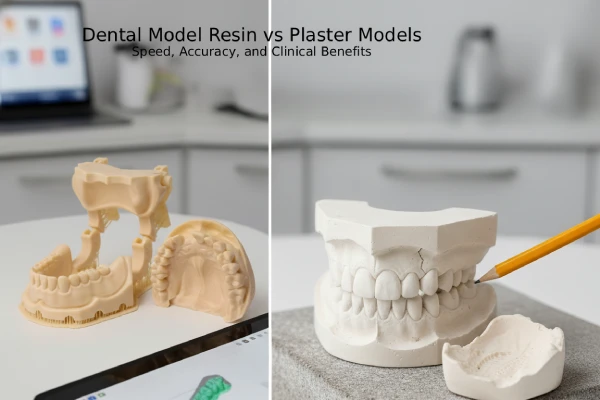The Shift from Plaster to Digital Models
For decades, plaster models have been a cornerstone of dental laboratories and clinics. They’ve served as reliable replicas of patients’ oral anatomy for diagnostics, treatment planning, and prosthetic fabrication. However, with the rise of digital dentistry, 3D printing using dental model resin has rapidly transformed how these models are produced.
Today, dental professionals face an important choice — to continue using traditional plaster models or transition to 3D printed resin models. This article compares both options in terms of speed, accuracy, and clinical benefits, helping you understand which solution better fits modern dental workflows.

Production Speed: From Hours to Minutes
Plaster Models: Manual and Time-Consuming
Traditional plaster models require several manual steps: mixing the gypsum, pouring it into an impression, waiting for it to set, trimming, and finishing. The entire process can take 45 minutes to several hours, depending on case complexity and technician experience.
Dental Model Resin: Digitally Efficient
With resin-based 3D printing, once the intraoral scan or digital impression is ready, the model can be printed automatically. Depending on the printer’s resolution and layer height, a full-arch model can be produced in less than an hour — often while the technician works on other tasks. After printing, minimal post-processing (washing and curing) is needed, making turnaround times up to 70% faster than with plaster.
Speed Advantage Summary:
- Faster production and batch printing
- Automated workflow reduces manual labor
- Ideal for same-day model delivery or chairside applications
Accuracy and Dimensional Stability
Plaster Models: Prone to Shrinkage and Deformation
Gypsum is sensitive to moisture, temperature, and handling. Over time, plaster models can chip, expand, or lose precision — especially when stored for long periods. Small dimensional errors may affect fit and occlusion accuracy in restorations or aligners.
Dental Model Resin: Digitally Precise and Stable
High-quality 3D printing resins for dental models are formulated for exceptional accuracy and minimal shrinkage. With printer resolutions as fine as 50 microns, the resulting models maintain consistent dimensions and surface detail. Unlike plaster, resin models are resistant to humidity and maintain their geometry over time, ensuring reproducible results for crown, bridge, or implant workflows.
Accuracy Advantage Summary:
- Micron-level precision from digital data
- No risk of distortion during storage
- Consistent results across multiple prints
Surface Quality and Detail Reproduction
Plaster Models
While plaster can capture fine detail from a good impression, manual trimming and finishing can cause surface imperfections or edge loss. The matte texture is acceptable for general diagnostic use but less ideal for precision prosthetic fitting.
Resin Models
3D printed resin models exhibit sharp edges, smooth surfaces, and excellent detail resolution — ideal for clear aligner forming, diagnostic wax-ups, or implant planning. The surface quality also enhances the visibility of margins and undercuts during design or fitting.
Detail Advantage Summary:
- Smooth, clean surfaces for optical scanning or adaptation
- No manual trimming required
- High repeatability for multiple cases
Workflow Integration and Digital Compatibility
Plaster: Analog and Isolated
Plaster models require physical impressions, manual pouring, and cannot easily be integrated into digital workflows such as CAD/CAM or intraoral scanning. Sharing data with partners or specialists often means shipping physical models.
Resin: Digital and Connected
3D printed models fit perfectly into digital dentistry ecosystems. Designs can be shared instantly via STL files, modified in CAD software, and printed anywhere with the same precision. This enables remote collaboration between clinics, labs, and design centers, reducing logistics time and improving communication.
Workflow Advantage Summary:
- Fully digital from scan to model
- Easy duplication and cloud-based storage
- Scalable production for multi-case printing
Clinical and Practical Benefits
For Dental Clinics
- Faster chairside turnaround
- Easier patient communication with realistic models
- Improved hygiene and storage efficiency
For Dental Laboratories
- Increased throughput and repeatability
- Simplified model management
- Reduced material waste and rework
For Educational or Training Use
- Durable and reusable models for teaching
- Can simulate multiple cases or pathologies easily
Cost Considerations
While the initial investment in a 3D printer and resin materials can be higher than gypsum, long-term operational costs are lower due to reduced labor, waste, and time. Moreover, resin models are reusable for design verification and can be archived digitally, eliminating the need for large storage spaces.
Cost Perspective Summary:
- Higher upfront, lower recurring cost
- Less technician time = higher productivity
- No material mixing or model breakage losses
Environmental and Safety Aspects
Modern dental model resins are typically non-toxic and low-odor, meeting biocompatibility standards. Additionally, digital workflows eliminate plaster dust and water waste associated with traditional model production.
Toward a Fully Digital Dental Model Workflow
The shift from plaster models to dental model resin represents more than a material change — it marks a step forward toward efficiency, precision, and scalability in modern dentistry.
By embracing 3D printed resin models, dental professionals gain:
- Significantly faster turnaround
- Consistent, precise model reproduction
- Integration with digital design and manufacturing tools
While plaster still serves basic modeling needs, the advantages of dental model resin are undeniable for clinics and labs pursuing digital transformation and enhanced productivity.


